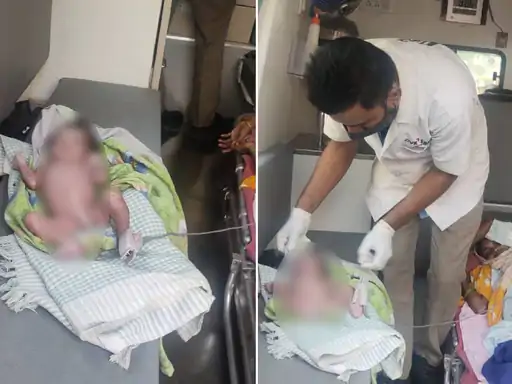🌧️ Trapped in a Toilet Amid the Flood: The Miraculous Rescue of a Newborn in San Joaquin, Philippines 🌧️

As relentless rains pummeled San Joaquin, a small town in the Philippines, the skies seemed to weep endlessly. Streets were submerged, rivers overflowed, and families huddled inside their homes, praying for the storm to pass. But amid the roar of thunder and the rising floodwaters, a desperate cry echoed from an unlikely place — a tiny newborn trapped inside a toilet.
It was a story no one could have imagined.
Maria, a young woman with intellectual disabilities, had lived quietly with her family in a humble home on the outskirts of town. The floods had already made life difficult, with water seeping into their rooms and food running low. But nothing could prepare them for what happened that fateful morning.
Maria had gone to the bathroom as usual, hoping to find a brief moment of privacy amid the chaos outside. What no one knew was that Maria was pregnant — a fact hidden even from her family. Suddenly, in the cramped, water-damaged toilet, labor pains struck unexpectedly.
In a terrifying twist of fate, Maria gave birth alone, with no one around to help. The newborn, fragile and helpless, slipped and became lodged inside the toilet’s commode pipe, stuck and unable to move.
The terrifying silence was broken by Maria’s muffled cries for help.
Her family rushed to the bathroom, only to find her unconscious and the baby’s faint whimpers trapped inside the toilet bowl. Panic set in instantly. The floodwaters continued to rise, threatening to engulf their home and wash away any hope.
With trembling hands, Maria’s relatives called the local fire department. Despite the heavy rain and dangerous conditions, the firefighters arrived quickly, their trucks splashing through flooded streets as sirens cut through the storm.
Captain Reyes, leading the rescue team, recalled the scene: “It was like nothing I had ever seen. A baby trapped inside a toilet during a flood—time was against us, and every second counted.”
The firefighters immediately sprang into action. Using specialized tools, they carefully dismantled the bathroom’s plumbing, working against the clock as water levels continued to climb inside the home.
The operation was delicate. One wrong move could injure the baby or worsen Maria’s condition. But the team’s determination was unwavering.
Twenty-five minutes felt like an eternity as they labored. Outside, neighbors gathered, holding umbrellas, praying silently as lightning flashed overhead.
Finally, with a soft cry that seemed to pierce the storm’s roar, the baby was freed — wet, frightened, but alive.
Paramedics quickly wrapped the tiny infant in warm blankets and rushed both mother and child to the nearest hospital.
News of the miraculous rescue spread like wildfire through San Joaquin and beyond. People marveled at the courage and skill of the firefighters, and the resilience of a tiny life that refused to be extinguished even in the face of nature’s fury.
At the hospital, doctors confirmed that both mother and baby were stable, though exhausted. Maria’s family thanked the rescuers with tears in their eyes, overwhelmed by the miracle they had witnessed.
But beyond the dramatic rescue, this story sheds light on a deeper issue — the vulnerability of the most marginalized during natural disasters. Many communities in the Philippines face similar challenges, where access to healthcare is limited, and emergency services are stretched thin.
Maria’s case was a stark reminder that even in the worst conditions, humanity’s compassion and bravery shine brightest.
Captain Reyes reflected, “Our job isn’t just to fight fires or battle floods — it’s to save lives, no matter how small or how unlikely the situation.”
As the floodwaters slowly receded, life in San Joaquin began to return to a fragile normal. But the story of a baby born and rescued from a toilet amid a flood would be told for years to come — a testament to hope, resilience, and the extraordinary courage of ordinary people.





